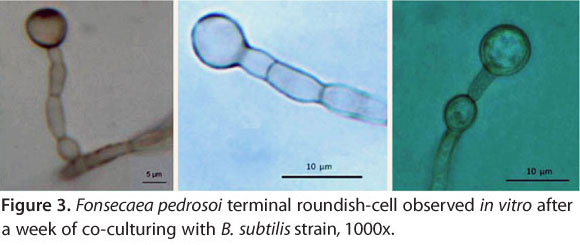Interactions among microorganisms may be the cause of morphological modifications, particularly in fungal cells. The aim of this work was to examine the changes that occur in cells of the fungus Fonsecaea pedrosoi after in vitro co-culturing with Bacillus subtilis and to explore the results of this interaction in vivo in an experimental murine infection. B. subtilis strain was inoculated into a 15-day pure culture of F. pedrosoi. In vitro, after 48 hours of co-culturing, the fungal cells were roundish. The secretion of fungal dark pigments and production of terminal chlamydoconidia were observed in hyphae after one week. In the in vivo study, two animal groups of 30 BALB/c mice each were employed. One group was inoculated intraperitoneally with hyphal fragments from the co-culture of bacteria and fungi; the other group was infected only with F. pedrosoi hyphae. After seven days of infection, both animal groups developed neutrophilic abscesses. Phagocytosis of bacilli by macrophages occurred at three days. At later periods, generally after 25 days, only roundish cells similar to sclerotic bodies remained in the tissues while hyphae were eliminated by 15 to 20 days. These fungal forms originated mainly from terminal chlamydoconidia. The co-culturing between bacteria and fungi may constitute a mechanism to rapidly obtain resistant fungal forms for host defenses, especially for chromoblastomycosis (CBM) experimental infections.
Bacillus subtilis; Fonsecaea pedrosoi; microbial interaction; co-culture; fungal antagonism





